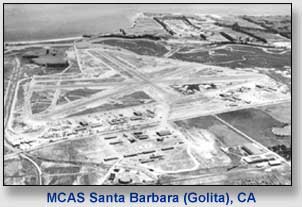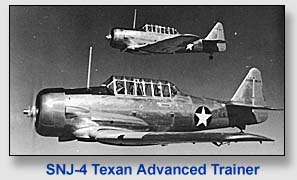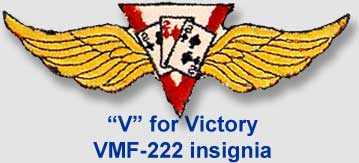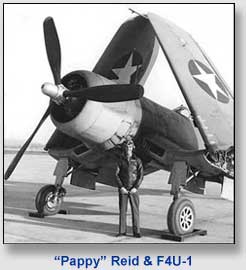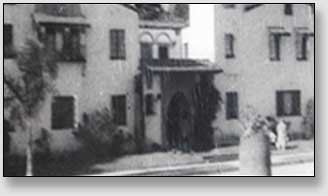 |
 |
|
|
|
|
|
|
|
|
The source of the moniker, “Flying Deuces,”
is usually attributed to its squadron number. Of note, RKO Pictures
released a feature length film titled, “The
Flying Deuces,” in 1939 starring Stanley Laurel and Oliver
Hardy. The plot has the hapless pair (the “Deuces” of
the title) joining the French Foreign Legion and in its dénouement
has the pair trying
to fly a plane in order to desert the Legion. The result is
classic Laurel & Hardy slapstick. This webmaster asked his inspiration
and primary resource for this project, Lt. Col W.O. “Pappy”
Reid, if he thought the film was the origin or an influence on the
VMF-222 nick-name but he claimed ignorance of the film or that it
had any correlation to it. Said webmaster respectfully disagrees
with the late and presumed last of the "Flying Deuces." |
|
Hell, We can’t use these Corsairs we ordered, allegedly
said the admirals. Give them to the Marines!
|
|
|
Stationed at Ewa,
VMF-222 missed the pivotal naval battle at Midway and in September
the squadron rotated “states side” to the new MCAS
Santa Barbara, California. While there, the squadron filled its
billet of pilots and ground support crew and also nicknamed themselves
“The Flying Deuces” and acquired its iconic logo. The
squadron’s intelligence officer, Warrant Officer George C. Schaefer,
Jr,. designed the first "Flying Deuces" insignia and the
"V" for Victory patch was a variation oftern sewn onto baseball
caps, a flag, etc. “Gunner” Schaefer also used his talent
as a former Warner Brothers studio photographer to document much of
the squadron’s activities that appear in this website.
|
| |
|
| |
|
| |
|
| |
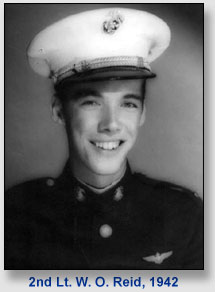 |
|
“I arrived at San
Diego, Cal, from my leave Sept. 10, 1942. Stayed
there until Oct. 10, 1942 was transferred to
Santa Barbara, Calif, where I was assigned to
“The Flying Deuces” Squadron. (VMF-222).”
-excerpt from diary of 2nd Lt. W. O. Reid, USMC-R |
| |
|
| 2nd Lt. Reid at 21 years old. He just received his
wings and commission on August 16, 1942 at NAS
Miami. |
|
| |
| Williams,
Reid, Wilson, ?, Newlands,
Hobbs, & Turner (Volcansek?) |
|
|
|
|
“Pappy” encounters another “Pappy”
During the month in San Diego awaiting assignment, 2nd Lt.
Reid was billeted at North Island Naval Base, across the bay from
the city and home of the fleet. He often went by navy launch over
to “main side” for after hours entertainment. The caveat
was that he and his fellow junior officers had to be back at the
town’s wharf opposite the navy base before midnight to catch
the last launch back. There was an early roll call every morning
and not to be there would be a black mark on your record. What to
do?
Just before midnight “Pappy” Reid and a group of
other pilots arrived at the designated embarkation point only to
see the last launch heading back to base full of other men.
After many minutes of cussing and complaining, one of the group
stated that he couldn’t wait any longer. He stripped down
to his “skivvies,” handed his clothes to his buddies
and then dove into the black and frigid bay, swimming towards the
base about one half mile away. Marveling at the man’s audacity,
the others stood there trying to figure a more conventional way
back to the base. In about fifteen or twenty minutes the opposite
side of the bay where the fleet was anchored there arose a wall
of search lights and howling sirens. Minutes later San Diego police
showed up at the pier and inquired of the group of marines and sailors
if anyone saw some “Jap[anese] frogmen in the bay?”
'No,' the stranded servicemen amswered, 'we haven't seen any
'Japanese' frogmen.' Satisfied, the cops got back into their patrol
car and left to search elsewares. Soon after the police departed
the 'not-a-Japanese-frogman' pops up near them and the men help
him up to the pier. The swimmer stated that he was swimming up to
a battleship when a sentery must have spotted him so he turned around.
A dividend of all the excitement was that a navy launch arrived
soon after and took them back to the base. On the way back “Pappy”
Reid asked one of the swimmer’s buddies he was. ‘Oh
he’s Greg Boyington, “Pappy” Boyington, back from
China flying with the Flying Tigers.'
- conversation with Lt. Col. W. O. "Pappy" Reid, USMC-Ret |
 |
|
|
|
| While at MCAS Santa Barbara, the pilots trained in fighter
tactics, and navigation in SNJ-4
“Texans” and occasionally F4F
“Wildcats” until it acquired two of the earliest F4U-1A
“Corsair” fighter planes in the Marine Corps. |
 |
| |
| Note the left shoe of the front right pilot (Reid). He's
wearing Jodhpur strap boots, a fashion statement among marine
fighter pilots. Anther way that marine fighter pilots distinguished
themselves from other aviators was to leave the topmost button
unbouutoned when wearing their tunic. The fad was scotched
when a general officer discovered the esoteric dress code.
|
|
| |
VMF-222 pilots: Max Volcansek (CO), H.
"Bud" Turner, J. "Benjoe" Williams,
?, W.O. "Pappy" Reid, Don Sapp. Note the Sam
Browne belts. |
|
| |
| |
| |
| |
| 2nd Lt. W. O. Reid with the Corsair he ferried up
from NAS
North Island to MCAS Santa Barbara. For comparison
the plane was 16' 1" high, the props 13' 3"
in diameter, and Lt. Reid is 6' tall. |
|
|
‘The CO [Commanding Officer] and I hopped a
ferry flight down to San Diego [1/18/1943] to bring
back the first two of our F4Us. My jaw dropped when
I saw my plane- it was so BIG! The largest fighter
in the world I think. It had 13’ props [propellers]!
We read the F4U’s pilot’s manual on the
plane down to San Diego but we had so many questions
about its performance. Luckily there were some Navy
pilots there who had flown the Corsair already and
they gave us some hard-earned advice- when landing,
the left wing will suddenly drop at about stalling
speed so you have to come in “hot.” Be
careful of hitting your brakes too soon or hard too;
the “Hog” [nicknamed so by the Navy pilots
because of its long-14’ fuselage forward of
the cockpit and obstructive-takes away 12 degrees
of view from the pilot’s forward visibility]
has a tendency to rise off of its tail wheel and then
dig those long props into the deck. Oh yeah, that’s
why we rejected it for carriers-along with its high
bounce too. We’ve lost some good pilots so far
trying to correct for those problems. When it’s
in the air, though, you’ll love it. Good luck!’
- conversation with Lt. Col. W.O. Reid |
| |
|
| |
| This
F4U-1, BUAir #02277, was one of the first of two Corsairs
issued to VMF-222. Capt. Don Sapp is the man above
on right. |
|
| |
|
| |
"We were 'the cat's meow.'"
|
|
When the marines
landed at the
old Santa Barbara county airport in 1942 to make it
theirs, the small, epomninous California county seat would
never be the same. Founded by Spanish Francsicans in 1782,
it had become one of the Golden State's famous retreats
of the rich and the famous from Los Angeles and beyond.
The marine aviators soon had the situation "well in
hand" with the femle residents. |
 |
| An apartment was shared by four of the "Flying Deuces"
in this Santa Barbara complex; address unknown. |
2nd Lt. W.O "Pappy" Reid posing with his 1942
Pontiac Streamliner Coupe. This was the last year of production
until 1946. He bought it new and stored it when he was shipped
overseas. |
|
| But now, after only one month getting to know thier
new F4Us, VMF-222 was ordered to pack up and fly their 13 Corsairs
to North Island Naval Air Satation, San Diego to sail for "parts
unknown." |
| |
| |
|
| |
| |
|
 |

